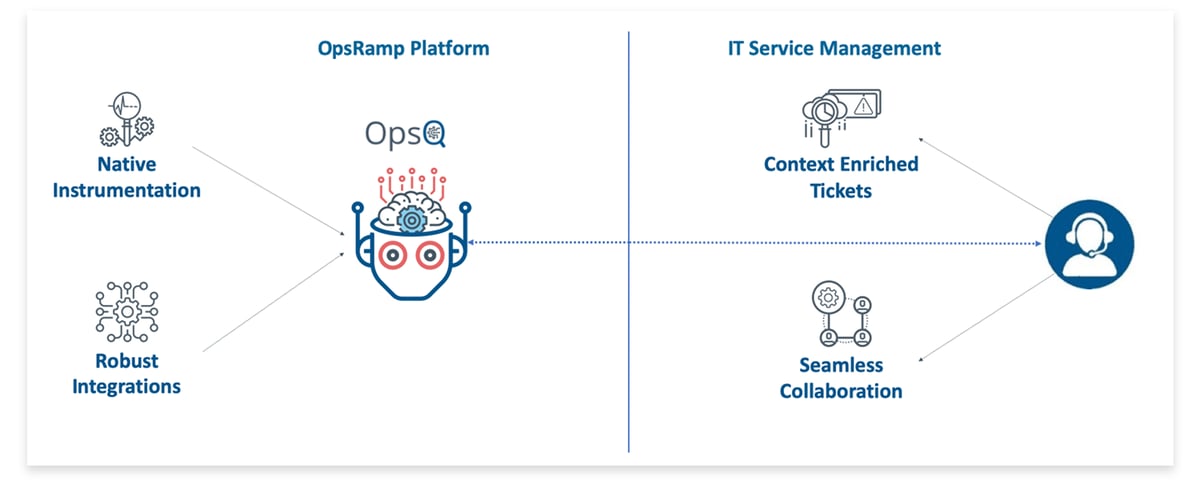Our recent webinar on Stop Swivel-Chair IT Operations with OpsRamp and ServiceNow ITSM featured Curt Thorin, Solutions Strategist and Jordan Sher, Director of Corporate Marketing. The webinar addressed the challenge of managing alerts and remediating incidents at scale and how the right automation and ITSM integration investments (powered by AIOps) are helping enterprises address the problems of alert storms and service degradations.
The Challenge of Swivel-Chair IT Operations
The rise of DevOps and fragmented, shadow IT decisions have led to more point tool adoption for hybrid infrastructure monitoring. Siloed point tools bring in greater complexity for enterprises seeking to accelerate digital transformation outcomes. IT teams need to adopt a “swivel-chair” approach to incident management, swapping between screens and moving between different point tools, for a contextual view of overall IT service health and availability.
This fragmented monitoring landscape (see our post on the so-called single pane of glass) has resulted in alert fatigue, where administrators can’t determine the root cause of IT outages fast enough, putting at risk the health and performance of business-critical IT services. Alerts arrive without context and teams need to manually consolidate and prioritize them. In this scenario, a service-centric AIOps solution can deliver value in terms of faster issue recognition, rapid mean-time-to-recovery, and unified operations.
Service-Centric AIOps to the Rescue
Service-centric AIOps is a better approach than disconnected point tools to address the problems of alert fatigue, constant firefighting, and IT staff burnout. OpsRamp helps both IT operations and service delivery teams prevent digital disruptions by proactively monitoring system health, reducing alert storms and remediating issues quickly through intelligent incident management for ServiceNow ITSM, including:
- Autonomous Discovery and Instrumentation: OpsRamp’s auto-discovery will find resources across on-prem and multi-cloud platforms and help IT teams pinpoint real-time infrastructure dependencies for legacy and modern services.
- Hybrid Infrastructure Monitoring: OpsRamp helps IT infrastructure teams keep a close eye on issues that could affect uptime, like capacity, configurations, and degraded performance, through a proactive framework of hybrid monitoring policies.
- Contextual Auto Remediation: OpsRamp applies programmatic remediation for well-defined IT operational issues and ensures faster recovery using policy-driven automation. DevOps teams can spend time delivering the right customer experiences without having to invest their energies in troubleshooting repetitive incidents.
OpsRamp’s service-centric AIOps helps IT teams restore and repair services faster with automated root cause analysis and agile incident response. Enterprises can isolate and diagnose problems quickly, drive accurate resolution with the right event intelligence, and route incidents efficiently to the proper teams.
As hybrid infrastructure, point tool sprawl, and shadow IT continues to burden IT teams, OpsRamp provides the framework to simplify service context, management and health. OpsRamp’s bi-directional integration for ServiceNow ITSM ensures that all the work performed in OpsRamp is seamlessly transferred over to ServiceNow. Conversely, any notes or updates in ServiceNow will show up in the OpsRamp alert browser for faster incident triage and better service compliance.
 Figure 1 - OpsRamp’s bidirectional integration for ServiceNow allows IT operations and service delivery teams to do their jobs without ‘swivel chairing’ between multiple tools.
Figure 1 - OpsRamp’s bidirectional integration for ServiceNow allows IT operations and service delivery teams to do their jobs without ‘swivel chairing’ between multiple tools.
Watch our webinar to see the future of AIOps-enabled, service-centric, hybrid IT management, monitoring, and remediation come to life. Then schedule a custom demo for your own organization. The OpsRamp team will also be at Knowledge 2019, where we hope to connect with you there.
Next Steps:
- Understand how our service-centric AIOps solution helps control alert storms and establishes probable root cause for a service outage.
- Read 451 Research’s report on how OpsRamp is driving innovation with machine-learning powered AIOps.
- Schedule a custom demo with an OpsRamp solution expert.

![[Webinar Highlights] Stop Swivel-Chair IT Operations with OpsRamp and ServiceNow ITSM](https://blog.opsramp.com/hubfs/Blog_images/Stop-Swivel-Chair-IT-Operations-hero.jpg)




